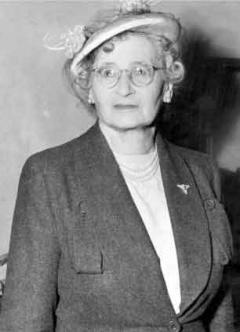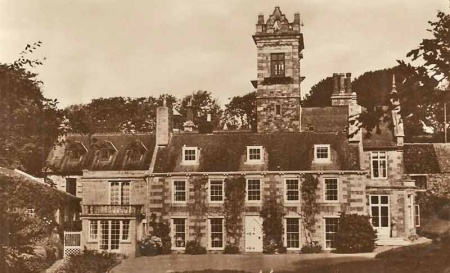Sark-Jersey links
Dame Sybil Hathaway
|
Spiritual conquest
The first known link between Jersey and Sark is connected with St Magloire who had cured a certain Count Loiseau in Normandy, as a result of which the Count asked him to make a spiritual conquest of Sark. The Saint agreed and came to Jersey soon after the death of St Helier and in AD 565 he crossed to Sark with 62 followers, some of whom no doubt must have been Jerseymen.
After he died his body was secretly removed by order of a Count Nivo and taken to St Mannelier in Jersey. Some centuries later it was again removed and taken to the Priory of Lehon near Dinan and finally his relics are now in the Church of St Jacques du Haut Pas in Paris where they are carried in procession every year on 24 October.
Mill dispute
In the Assize Rolls of 1233 there is a reference to the Abbot of Montebourg suing the Prior of Sark for the mill and rights. They were both summoned to St Helier in Jersey for their dispute to be tried. The judgment appeared to be that the mill and revenue belonged to the King and was in the possession of the Prior, who was conducting the service for his lord the King for a payment of 15 livres tournois a year.
Later Pleas of the Crown were held regularly in Sark, and a note from the English Exchequer in 1238 says that the allowance for the food of the Convent of St Magloire in the Island of Sark must be paid.
About 1412 Henry V confiscated all the foreign priories, and from that date the monks appear to have existed in penury and hardship, being constantly attacked by pirates until they finally ceased to inhabit Sark and a secular priest from Guernsey carried on the service of the Chapel of St Magloire. At this time a census of the churches of the diocese was made by the Bishop of Coutances, in which Sark was rated at one twelfth of the Deanery of Guernsey, from which we can estimate that a fairly large population existed there.
In 1460 de Breze Comte Maulevrier, having seized Mont Orgueil declared himself Seigneur of Jersey and Sark, which proves that there must have been some link between the two Islands. Edward IV granted a licence to 15 men from Jersey to export grain from England because of their great bravery at the capture of Mont Orgueil under Sir Richard Harliston, and among the names of these men is one called Peter the Serquais,
Uninhabited
Until 1549 there seems to have been no further mention of Sark until, in Falle's Chronicle, it is recorded that, there being a war between Edward VI of England and Henri II of France, a fleet of 11 French Galleys anchored off the Eperquerie and effected a landing, because no one was there to defend the island, as for a hundred years it had been uninhabited.
They put ashore a Captain Bruel and 400 men. They constructed three forts, the remains of which may be seen at La Tour and at the Hog's Back and on Little Sark. After five or six years the French became disheartened and all but 30 men went back to France, so that a party of Flemings coming ashore at night were able to capture the island by a ruse which is recounted by Sir Walter Raleigh when he was Governor of Jersey. The Flemings offered Sark to Queen Mary, but she gave them no reward nor recompense, although in order that it might not be recaptured by the French, Sir Hugh Paulet was despatched from Jersey to demolish the forts, after which the island seems to have been again uninhabited.
Helier de Carteret
In 1564 Sir Helier de Carteret of St Ouen, seeing that Sark had become a repair of pirates and wreckers, landed and surveyed the island and cultivated a small piece of land to see if the soil was good, and the following year, having ascertained that the crops were abundant, and much encouraged by Madame, his wife, he decided to colonise it.
In all Sark there was no dwelling, so Monsieur de St Ouen and his lady took shelter in a little vaulted chapel near which they built their home with a fair view across to St Ouen in Jersey. Having achieved this, he went to England to present to the Queen his plan to protect and colonise the island. Her Majesty received him and, after taking counsel of her Privy Council, created Sark a Fief Haubert and gave it to him for ever, on payment annually of the twentieth part of a knight's fee, now valued at £1 15s 9d, which I still pay every year at Michaelmas.
This Patent or Charter, dated 6 August 1565, gave him six pieces of artillery from the Tower of London, one of which I have with the inscription "Don de sa Majeste la Royne Elizabeth au Seigneur de Serk". There was also a condition that he should bring 40 families from Jersey, each man with a musket, for the defence of the island, and it is the descendants of these men with their distinct Jersey names that is our strong link with Jersey today.
At first the Eperquerie was used as a landing, but soon the Seigneur caused a new harbour to be made at a creek facing Jersey called the Chaussee St Chene, but access had to be pierced through rock to a beach where a row of capstans enabled boats to be safely drawn ashore when gales blew from the south.
In 1571 a synod was held in Sark to nominate Cosme Brevint as first Minister of the Island; the Seigneur later paid for the education of his nephew Elie Brevint in Geneva and it is to this Elie, who became the minister or Chaplain in 1605, that we owe the recording of so much of the history of the de Carteret times. His notebook was found hidden in the rafters of the old Manoir, no doubt put there for safety in troubled times.
Jurisdiction like Jersey
In 1579, just before the death of Helier, it was rumoured that a commission was to be sent from England to enquire into the state of the Island, whereupon the inhabitants, fearing that they might be ruled by Guernsey, petitioned the Seigneur through his son Philip, who was acting Seigneur for his father, that he should establish a court and jurisdiction in every way similar to that of Jersey. This resulted in the appointment of one Edward de Carteret as Seneschal, and the Seigneur decided that the people should have a share in governing themselves so that ten Jurats were named, whose descendants nearly all exist in Sark to this day.
The actual Chief Pleas, constituted more or less as we know it, was not established until 1675, by Order in Council. A contract dated 1691 shows that Sir Philip de Carteret leased Sark with all its revenues to Daniel Valpy of Jersey, called Janvrin, Sir Philip died before the contract ended and as his son Charles was a minor his mother claimed her dower on Sark. In 1693 Sir Philip had made a conveyance in trust of Sark to Sir Robert Atkins for five shillings, this was presumably to pay his debts because it was followed two months later by a licence from William and Mary to sell Sark, but nothing seems to have been done until 1713 when Queen Anne granted another licence to Sir Charles de Carteret to sell whole or in part or to dispose of by will.
He died two years later and his will was entered in the register of the Diocese of Winchester, leaving all the Island of Sark with its rights and liberties to his executors. They sold it in 1721 for £5,000. A few years later it was purchased by the heiress of the Le Gros family who had come to Sark with Helier de Carteret; she was the widow of Nicholas le Pelley from Guernsey, but her heirs, seven succeeding Seigneurs, can be said to have Jersey blood, and the last one when he sold Sark in 1852 retired to live in Jersey.
Finally my own family of Collings came from Jersey, as actually two brothers Collings, born at Ansford in Somerset, escaped from the Parliamentarians at Pendennis Castle and with other loyalists came to Jersey. One of them, described as a Major of the Fort of St Aubin, is buried at St Brelade; his grandson born there in 1712, married and settled in Guernsey in 1734, from whom I am descended.



